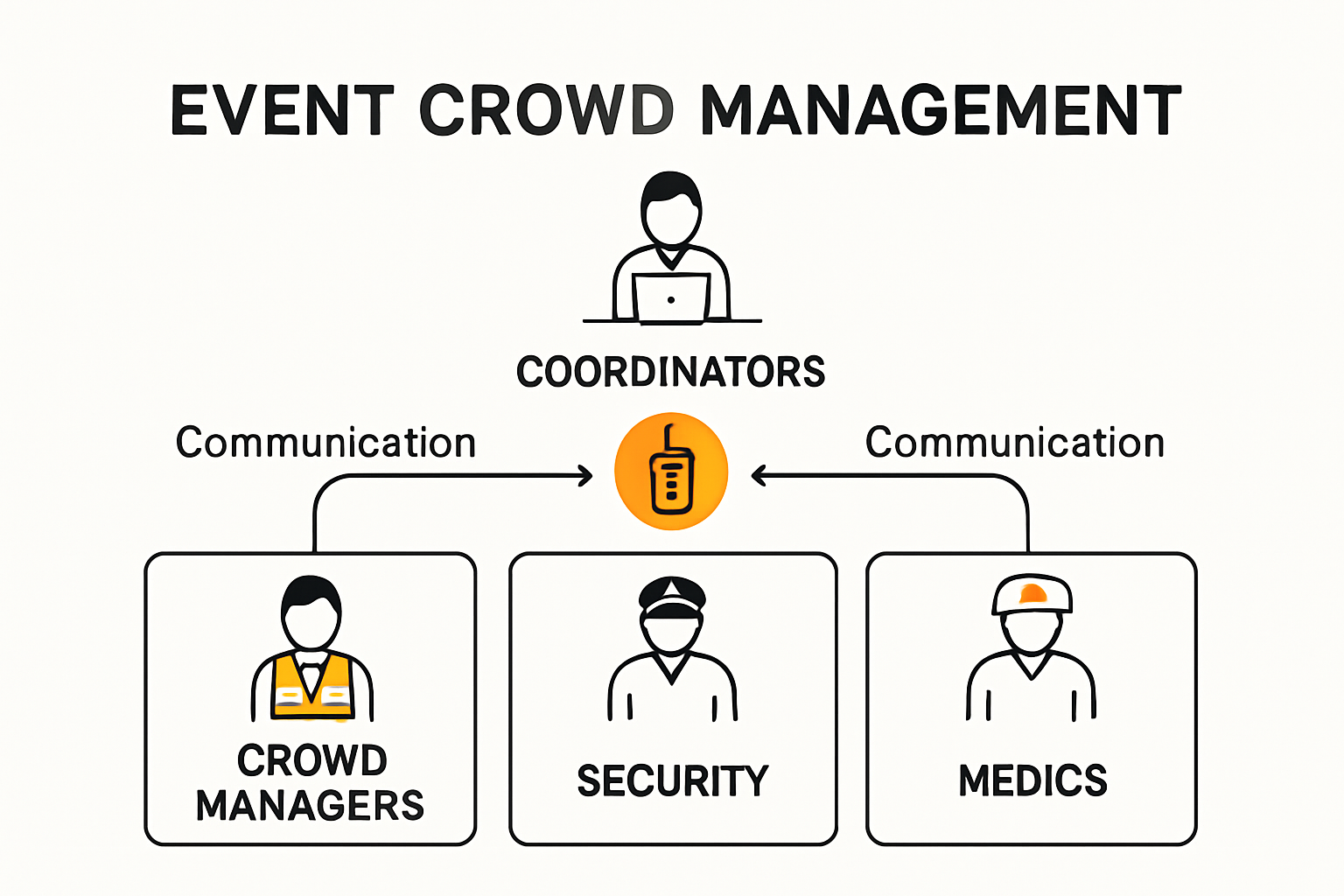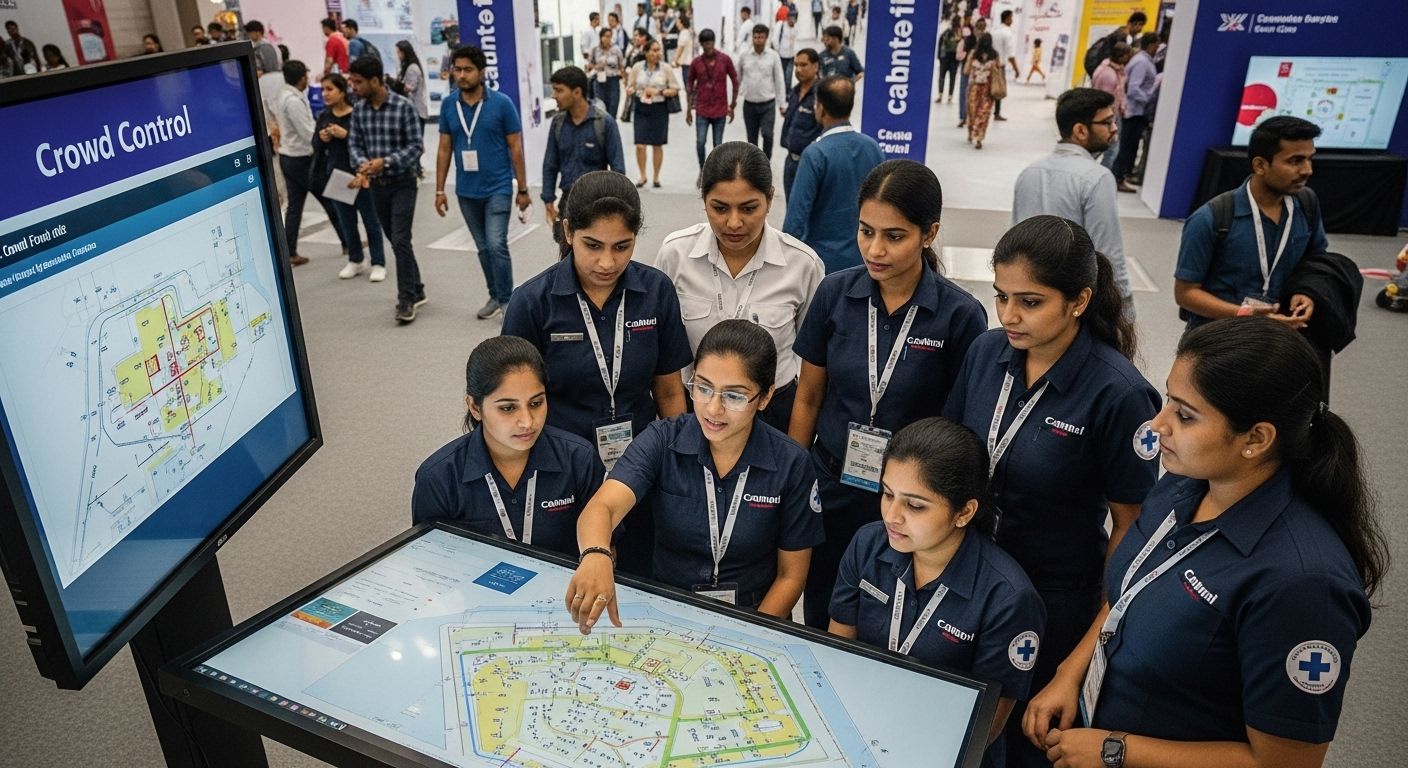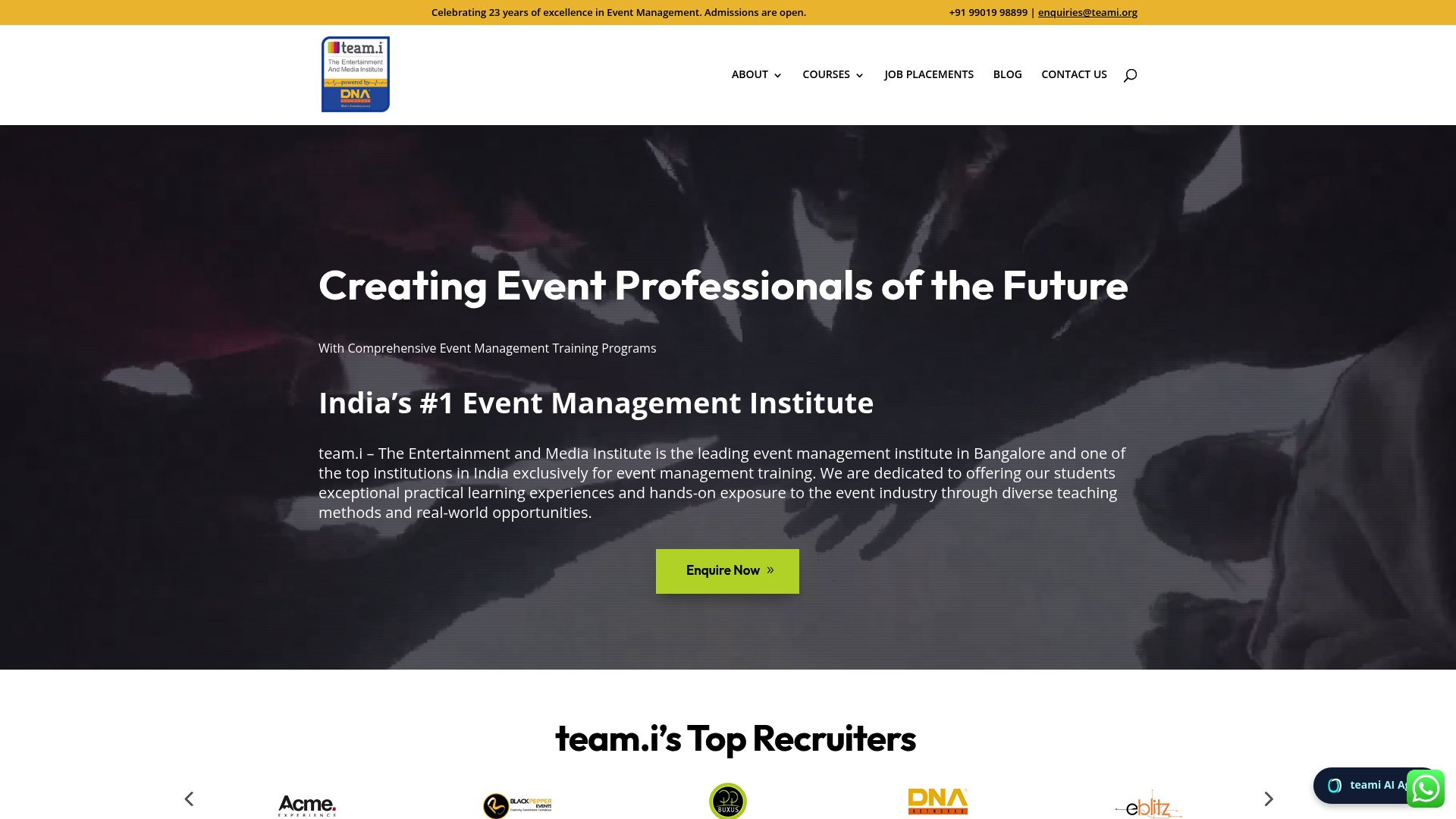Big crowds bring energy and excitement to any event, and with some gatherings reaching over 80,000 attendees at once, the stakes have never been higher for organizers. Most people assume simply adding more security makes things safe. The reality is that the smartest event planners rely on a mix of psychology, technology, and design to guide and protect every guest.
Table of Contents
- Understanding The Importance Of Event Crowd Management
- Key Strategies For Effective Crowd Control
- Roles And Training For Event Staff
- Technology And Tools For Modern Crowd Management
Quick Summary
| Takeaway | Explanation |
|---|---|
| Prioritize safety in crowd management | Effective crowd management prioritizes safety through risk assessment and strategic planning. Clear emergency routes must be established before events. |
| Leverage technology for monitoring | Advanced tools like AI and real-time tracking enhance crowd safety by anticipating density and flow issues, allowing proactive management. |
| Implement specialized staff training | Staff roles must include trained crowd managers and security personnel to ensure preparedness for emergencies and crowd dynamics management. |
| Focus on spatial design for crowd flow | Venue layout is critical; intuitive pathways and clear signage can manage crowd movements effectively, preventing bottlenecks and overcrowding. |
| Utilize effective communication protocols | Clear communication through multilingual signage and staff training ensures rapid response and information dissemination during events. |
Understanding the Importance of Event Crowd Management
Event crowd management is a critical discipline that goes far beyond simply counting attendees or directing people through spaces. At its core, crowd management represents a sophisticated approach to ensuring safety, maintaining order, and creating positive experiences for participants in large gatherings. Without strategic planning and implementation, events can quickly transform from exciting opportunities into potentially dangerous situations.
The Critical Role of Safety and Risk Mitigation
Safety stands as the paramount concern in event crowd management. According to the Canadian Centre for Occupational Health and Safety, effective crowd management involves comprehensive risk assessment, understanding occupant load, and carefully considering venue design and layout. Professional event managers must anticipate potential challenges before they emerge, developing robust strategies to prevent overcrowding, manage movement patterns, and create clear emergency evacuation routes.
The stakes of inadequate crowd management can be extraordinarily high. Large events like music festivals, sporting competitions, and cultural gatherings can quickly become high-risk environments if crowd dynamics are not carefully controlled. Research published in the National Center for Biotechnology Information highlights how sophisticated crowd management strategies can mean the difference between a successful event and a potential disaster.
Strategic Planning and Psychological Dynamics
Effective crowd management extends beyond physical logistics. It requires a nuanced understanding of human psychology and group behavior. Event managers must comprehend how crowds move, react, and potentially become overwhelmed or panicked. This involves studying crowd flow patterns, understanding potential stress points, and creating environments that naturally guide people while maintaining a sense of comfort and safety.
Professional crowd management integrates multiple disciplines. Crowd managers must be part logistician, part psychologist, and part emergency responder. They need to simultaneously monitor crowd density, manage entry and exit points, ensure accessibility, and be prepared to implement rapid response protocols if unexpected situations arise.
The complexity of crowd management is particularly evident in large-scale events. From religious gatherings like the Kumbh Mela to international sporting events, the principles remain consistent: anticipate potential risks, create clear movement pathways, maintain communication channels, and have contingency plans ready for rapid implementation.
For those interested in diving deeper into event management principles, explore our comprehensive guide on event management fundamentals to understand the broader context of this critical professional skill.
Ultimately, crowd management is not about restricting people but about creating environments where large groups can gather safely, enjoy shared experiences, and move smoothly through spaces. It represents a critical intersection of safety engineering, human psychology, and strategic planning that continues to evolve with technological advancements and changing social dynamics.
Key Strategies for Effective Crowd Control
Effective crowd control requires a multifaceted approach that combines strategic planning, technological integration, and human expertise. Successful event managers understand that crowd control is not about restriction but about creating smooth, safe, and enjoyable experiences for participants.
Technology and Advanced Monitoring Systems
Modern crowd control strategies leverage cutting-edge technologies to enhance safety and efficiency. Rensselaer Polytechnic Institute’s Environmental Health & Safety department emphasizes the critical role of trained crowd managers equipped with advanced monitoring tools. These technologies include real-time crowd density tracking, digital surveillance systems, and predictive analytics that can anticipate potential crowd movement challenges.
Smart monitoring systems now use artificial intelligence and machine learning algorithms to analyze crowd behavior. These systems can detect unusual patterns, identify potential bottlenecks, and provide instant alerts to event management teams. Thermal imaging cameras, crowd flow sensors, and advanced video analytics have transformed how event managers approach crowd control, allowing for proactive rather than reactive management.
Strategic Spatial Design and Movement Planning
Physical infrastructure plays a crucial role in effective crowd management. Event designers must carefully consider venue layout, creating intuitive pathways that naturally guide crowd movement. This involves strategic placement of barriers, clear signage, multiple entry and exit points, and creating buffer zones that prevent overcrowding in critical areas.
The case study of the Prayagraj Kumbh Mela 2019 provides an excellent example of complex crowd management. Organizers implemented sophisticated strategies such as unidirectional movement concepts, integrated transportation modes, and comprehensive traffic diversion plans. These approaches demonstrate how thoughtful spatial design can manage massive crowds effectively.
Human Expertise and Communication Protocols
While technology is crucial, human expertise remains the backbone of effective crowd control. Trained crowd managers must possess a unique blend of skills including situational awareness, quick decision-making, and excellent communication abilities. They serve as the critical interface between technological systems and real-world crowd dynamics.
Communication protocols are paramount. This includes clear, multilingual signage, well-trained staff positioned strategically throughout the venue, and robust communication systems that allow rapid information dissemination. Emergency communication channels must be established, ensuring that critical instructions can be quickly and clearly transmitted to large numbers of people.
For those looking to develop comprehensive event management skills, learn more about our professional event management training that covers these critical crowd control strategies.
The most successful crowd control approaches integrate technological solutions with human expertise, creating a comprehensive system that prioritizes safety, efficiency, and participant experience. As events become more complex and audiences more diverse, the ability to manage crowds effectively will continue to be a critical skill for event professionals across various industries.
Roles and Training for Event Staff
Event staff represent the critical human infrastructure that transforms event management from theoretical planning to practical execution. Their roles are diverse, complex, and require a sophisticated blend of technical skills, interpersonal abilities, and emergency preparedness.
Specialized Roles and Responsibilities
Event staff are not a monolithic group but a carefully structured team with specialized responsibilities. Key roles include crowd managers, security personnel, medical responders, communication coordinators, and logistical support staff. Each role demands unique skills and training, creating a comprehensive safety and experience management ecosystem.
Here is a summary table outlining the specialized roles of event staff and their key responsibilities, as discussed in the article:
| Role | Key Responsibilities |
|---|---|
| Crowd Manager | Monitor movement, manage flow, identify bottlenecks |
| Security Personnel | Perform threat assessment, de-escalate conflicts, respond to emergencies |
| Medical Responders | Provide rapid assessment and first aid |
| Communication Coordinator | Disseminate information, maintain emergency channels |
| Logistical Support Staff | Handle resources, venue setup, entry/exit logistics |

Crowd managers, for instance, must possess exceptional spatial awareness and psychological understanding. They monitor crowd movement, identify potential bottlenecks, and ensure smooth participant flow. Security personnel require advanced training in threat assessment, conflict de-escalation, and emergency response protocols. Medical responders need rapid assessment capabilities and the ability to provide immediate first aid in high-stress environments.
Professional Training and Skill Development
Comprehensive training is the backbone of effective event staff performance. Professional development programs focus on multiple dimensions beyond traditional technical skills. These include crisis management, communication strategies, psychological risk assessment, and advanced technological system navigation.
Training modules typically incorporate realistic scenario simulations, allowing staff to practice responses to complex crowd management challenges. These might include managing unexpected crowd surges, handling medical emergencies, implementing evacuation procedures, and maintaining calm during potential conflict situations. Specialized training programs emphasize the importance of situational awareness, quick decision-making, and maintaining composure under pressure.
Technology and Continuous Learning
Modern event staff training integrates cutting-edge technological tools and continuous learning methodologies. Digital platforms now offer immersive training experiences using virtual reality simulations, allowing staff to practice crowd management techniques in hyper-realistic environments without real-world risks.
Technological proficiency has become as crucial as traditional interpersonal skills. Staff must be comfortable using advanced monitoring systems, communication technologies, and real-time data analysis tools. This requires ongoing education and adaptation to rapidly evolving technological landscapes.
For aspiring event management professionals looking to understand the nuances of professional preparation, explore our comprehensive event management training resources to gain deeper insights into industry requirements.
Ultimately, event staff are more than support personnel. They are the critical human element that transforms event management from a theoretical concept into a seamless, safe, and memorable experience. Their training, skills, and dedication represent the difference between a potentially chaotic gathering and a smoothly executed event that prioritizes participant safety and enjoyment.
Technology and Tools for Modern Crowd Management
The landscape of crowd management has been revolutionized by technological innovations that provide unprecedented capabilities for monitoring, predicting, and managing large gatherings. Modern event professionals now have access to sophisticated tools that transform crowd control from a reactive to a proactive discipline.
The following table summarizes the modern technologies and tools mentioned in the article for crowd management and their core functions:
| Technology/Tool | Purpose |
|---|---|
| Real-time monitoring | Detect crowd density, identify bottlenecks |
| AI & Predictive Analytics | Analyze patterns, anticipate risks |
| Digital Signage/Apps | Direct crowd flow, provide live updates |
| RFID/Bluetooth/GPS | Track attendee movements, resource allocation |
| Thermal Imaging | Monitor temperature, assess health risks |
| Virtual Reality Training | Simulate scenarios, enhance staff preparedness |
Advanced Monitoring and Predictive Analytics
Cutting-edge crowd management technologies leverage artificial intelligence and machine learning to provide real-time insights and predictive capabilities. Research from the Journal of Public Transportation highlights the critical role of surveillance systems, people counting sensors, and geospatial analytics in ensuring public safety during large-scale events.
Smart camera systems now use advanced computer vision algorithms to track crowd density, movement patterns, and potential anomalies. These systems can instantly detect overcrowding, identify potential bottlenecks, and alert management teams before situations become critical. Thermal imaging technology adds another layer of monitoring, allowing event managers to assess crowd temperature distributions and identify potential health risks or emergency situations.
Digital Communication and Crowd Flow Management
Digital platforms have transformed how event managers communicate and manage crowd movement. Mobile applications now provide real-time updates to attendees, offering information about venue layouts, queue lengths, and potential congestion areas. Interactive digital signage can dynamically redirect crowd flow, helping to prevent overcrowding and optimize movement patterns.
Location tracking technologies enable precise crowd monitoring and management. RFID wristbands, Bluetooth beacons, and GPS-enabled technologies allow event managers to understand crowd movement in real-time, helping to make instant decisions about resource allocation, security positioning, and emergency response strategies.
Artificial Intelligence and Predictive Risk Assessment
Artificial intelligence has emerged as a game-changing technology in crowd management. Machine learning algorithms can now analyze historical data, current conditions, and multiple variables to predict potential crowd behavior and risk scenarios. These predictive models help event managers develop more sophisticated and proactive crowd control strategies.
Advanced AI systems can simulate crowd movement, test emergency scenarios, and provide recommendations for venue design and staff positioning. By processing vast amounts of data from previous events, these technologies can identify patterns and potential risks that might be invisible to human observers.
For professionals seeking to deepen their understanding of event management technologies, explore our comprehensive guide to event management tools and techniques to stay ahead of industry innovations.
The integration of these technologies represents more than just a technological upgrade. It signifies a fundamental shift in how we approach crowd management, transforming it from a primarily reactive discipline to a proactive, data-driven practice that prioritizes safety, efficiency, and participant experience. As technology continues to evolve, the future of crowd management promises even more sophisticated, intelligent, and responsive solutions.

Frequently Asked Questions
What is the primary goal of event crowd management?
The primary goal of event crowd management is to ensure safety, maintain order, and create positive experiences for participants attending large gatherings.
How can technology enhance crowd management at events?
Technology enhances crowd management by providing tools like real-time crowd density tracking, digital surveillance systems, and predictive analytics that help anticipate movement challenges and manage crowd flow effectively.
What are some key strategies for effective crowd control?
Key strategies for effective crowd control include leveraging advanced technologies, implementing strategic spatial design to guide movement, and ensuring that crowd managers are well-trained in communication and emergency protocols.
Why is staff training important in crowd management?
Staff training is crucial in crowd management because it equips personnel with the necessary skills to respond effectively to emergencies, manage crowd dynamics, and communicate clearly during events, thereby ensuring a safe experience for all attendees.
Take the Lead in Crowd Management With Expert Training
Ensuring the safety and success of any large event takes more than quick thinking and extra staff. As highlighted in this article, effective crowd management hinges on advanced strategies, real-time technology, and deep human expertise. If you are determined to prevent chaos and want to master safe crowd flow, specialized knowledge is crucial. At Event Management – team.i, we understand that today’s events demand professionals who can seamlessly integrate technology, spatial planning, and communication under pressure.

Do not leave the safety and experience of your attendees up to chance. Discover industry-leading courses that give you practical skills, hands-on exposure, and direct connections to top employers. Visit team.i.org right now and start transforming your event management career before the next crowd arrives.

